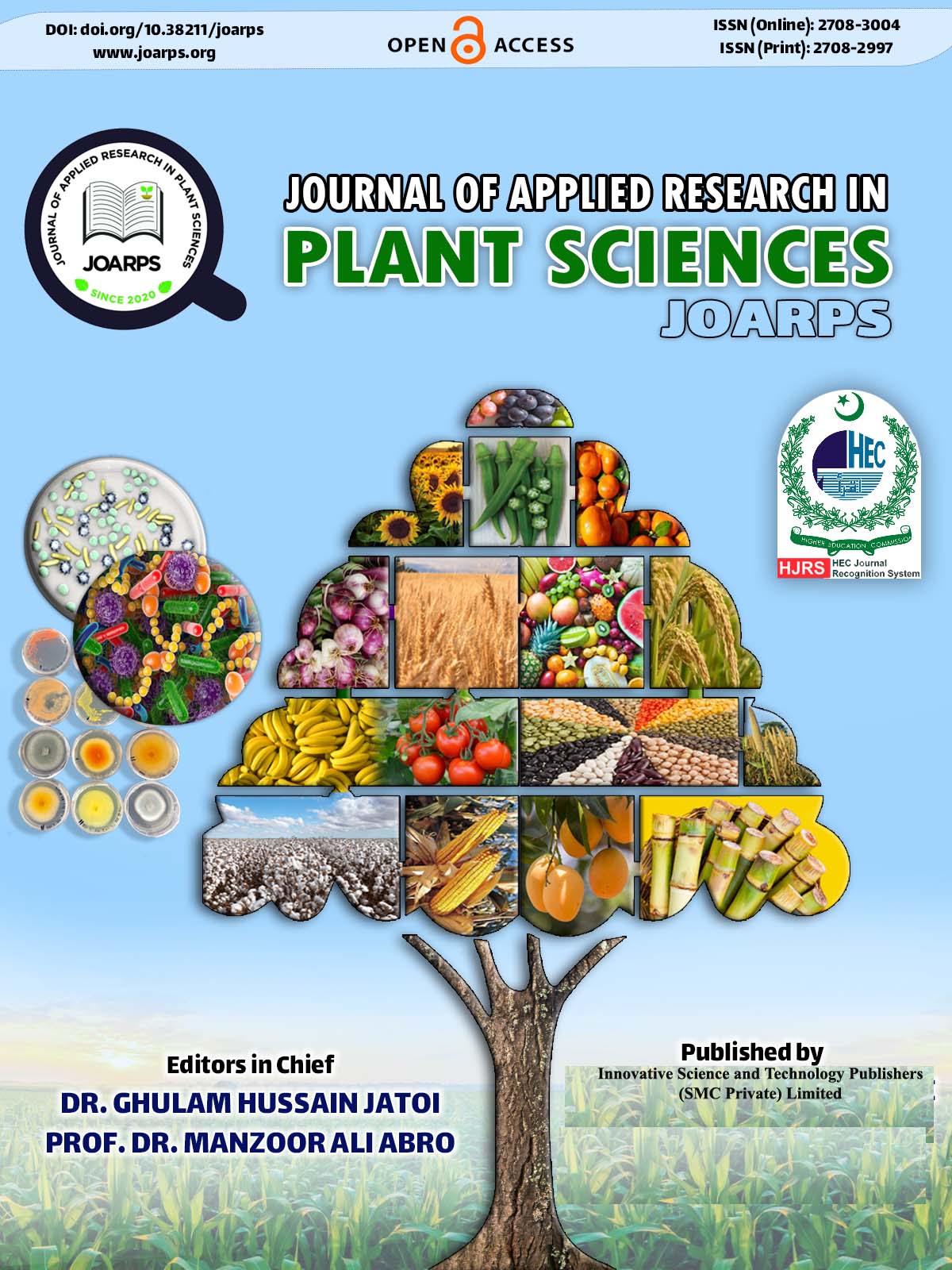Effect of Zn Applied with or Without Palm Stearin Coated Urea on The Growth and Mineral Element Concentration of Maize (Zea mays L.)
DOI:
https://doi.org/10.38211/joarps.2024.05.252Keywords:
Zn solution, control release urea, synergistic effect, mineral contents, hybridAbstract
Inhibition of ammonia (NH3) volatilization by deaccelerating urea hydrolysis rate in Central Anatolian lands is the indispensable approach for eco-friendly fertilization and nitrogen use efficiency (NUE). Nitrogen (N) and zinc (Zn) are critically limited here in alkaline soils. An experiment was conducted under controlled conditions to determine the availability of Zn applied as a solution and bound with polymer palm stearin (PS) coating material as a urease inhibitor. The treatments consisted of urea as a commercial commodity, urea with PS only, urea impregnated with PS and Zn, Zn-coated urea, and Zn in solution (SOL) form. During winter, 2019-20, the experiment was conducted in the glasshouse of the department of Soil Science and Plant Nutrition at Ankara University, Türkiye. Data indicated that Zn with PS and in SOL form produced more growth traits i.e., plant height (130 cm), stem girth (13.2 mm), shoot dry matter (4.63 g plant-1), root dry matter yield (0.61 g plant-1), and chlorophyll (42.16 mg g-1) content (p<0.01). Similarly, we had higher concentration of N (3.19%) and Zn (50.46 mg kg-1) content in maize plants (p<0.01) as compared to control. In conclusion, Zn at the rate of 10 mg kg-1 either in solution or coated with urea seems highly effective to sustain better crop productivity and NUE. While concerning N and Zn content, coated urea with Zn markedly responded as compared to Zn in SOL. Synergism between N and Zn can lead to better fertilizer management
Downloads
References
Affendi, N. M. N., Mansor, N., & Mathialagan, R. (2020). Development and characterization of allicin using palm stearin as a binder on urea granules. Journal of Plant Nutrition, 43(5), 621-628. DOI: https://doi.org/10.1080/01904167.2019.1701021
Noor Affendi, N. M., Mansor, N., & Samiri, S. S. (2020). Addition of chemical and natural urease inhibitors in reducing ammonia and nitrous oxide losses. Journal of Soil Science and Plant Nutrition, 20, 253-258 DOI: https://doi.org/10.1007/s42729-019-00136-6
Alloway BJ. (2008). Zinc in soils and crop nutrition. Brussels, Belgium: International Zinc Association
Arif, M., Jan, T., Riaz, M., Fahad, S., Arif, M. S., Shakoor, M. B., & Rasul, F. (2019). Advances in rice research for abiotic stress tolerance: agronomic approaches to improve rice production under abiotic stress. In Advances in rice research for abiotic stress tolerance (pp. 585-614). Woodhead Publishing DOI: https://doi.org/10.1016/B978-0-12-814332-2.00029-0
Babar SK. (2016). Effects of Cu and Zn coated urea on rice production in acidic and alkaline soils (Doctoral dissertation). http://ezproxy. upm. edu. my)
Babar, S. K., Yusop, M. K., Babar, S. A., & Khooharo, A. A. (2016). Consequences of Cu and Zn coated urea to minimize ammonia volatilization. J. Teknol, 78, 6-12. DOI: https://doi.org/10.11113/jt.v78.9209
Babar SK, Yusop MKB, Rajpar I, & Talpur NA. (2018). Urea Containing Coated Cu and Zn: A Suitable Fertilizer for Healthier Growth of Rice and N-Uptake. The Eurasia Proceedings of Science Technology Engineering and Mathematics, (2), 159-166
Babar SK, Hassani NA, Rajpar I, Babar SA, Zia HS, & Imran K. (2019). Comparison of Conventional and Encapsulated Urea on Growth and Yield of Wheat (Triticum aestivum L.). The Eurasia Proceedings of Science Technology Engineering and Mathematics, 6:181-187
Bremner JM. Total Nitrogen. In: Norman AG (ed) (1965). Methods of Soil Analysis: Part 2, chemical and microbiological properties, 9.2 American Society of Agronomy, Wisconsin pp 1149-1178 DOI: https://doi.org/10.2134/agronmonogr9.2.c32
Bouyoucos GH. A (1951). (1951). Recalibration of the Hydrometer Method for Making Mechanical Analysis of Soils. Agronomy Journal, 43:434-438 DOI: https://doi.org/10.2134/agronj1951.00021962004300090005x
Cakmak I, Kutman UB. (2018). Agronomic biofortification of cereals with zinc: a review. European Journal of Soil Science, 69 (1), 172-180 DOI: https://doi.org/10.1111/ejss.12437
Cakmak I. (2008). Enrichment of cereal grains with zinc: agronomic or genetic biofortification? Plant Soil 302, 1–17 DOI: https://doi.org/10.1007/s11104-007-9466-3
Cakmak I. (2002). Plant nutrition research: priorities to meet human needs for food in sustainable ways. Plant Soil, 247, 3–24 DOI: https://doi.org/10.1007/978-94-017-2789-1_1
Chen J, Cao F, Xiong H, Huang M, Zou Y, & Xiong Y. (2017). Effects of single basal application of coated compound fertilizer on yield and nitrogen use efficiency in double-cropped rice. The Crop Journal, 5(3), 265-270 DOI: https://doi.org/10.1016/j.cj.2017.01.002
Chien SH, Prochnow LI, & Cantarella AH. (2009). Recent developments of fertilizer production and use to improve nutrient efficiency and minimize environmental impacts. Advanced Agronomy, 102, 267-322 DOI: https://doi.org/10.1016/S0065-2113(09)01008-6
Choudhary, R.C., Kumaraswamy, R.V., Kumari, S., Sharma, S.S., Pal, A., Raliya, R., Biswas, P. & Saharan, V. (2019). Zinc encapsulated chitosan nanoparticle to promote maize crop yield. International Journal of Biology Macro molecule, 127, 126-135 DOI: https://doi.org/10.1016/j.ijbiomac.2018.12.274
Dong X, Li Y, Li Z, Cui Y, & Zhu H. (2012). Synthesis, structures and urease inhibition studies of copper (II) and nickel (II) complexes with bidentate N, O-donor Schiff base ligands. Journal Inorganic Biochemistry, 108, 22-29 DOI: https://doi.org/10.1016/j.jinorgbio.2011.12.006
Du N, Chen M, Liu Z, Sheng L, & Xu H, Chen S Kinetics and mechanism of jack bean urease inhibition by Hg 2+. Chemistry Central Journal, 6(1), 1-7 (2012). DOI: https://doi.org/10.1186/1752-153X-6-154
Engineers SoP . 2012–2018. Gas as fertilizer feedstock.
https://petrowiki.org/Gas_as_fertilizer_feedstock#cite_note-r3-3 [Google Scholar].
Sillanpää M Micronutrient assessment at country level: An international study. (1990). FAO Soils Bulletin No. 63, FAO, Rome
Grujcic D, Hansen TH, Husted S, Drinic M, & Singh BR. (2018). Effect of nitrogen and zinc fertilization on zinc and iron bioavailability and chemical speciation in maize silage. Journal of Trace Elements in Medicine and Biology, 49, 269-275 DOI: https://doi.org/10.1016/j.jtemb.2018.02.012
Heffer P, & Prud’homme M. Fertilizer outlook 2011–2015. International Fertilizer Industry Association (IFA), Paris
Horta, L.P., Mota, Y.C., Barbosa, G.M., Braga, T.C., Marriel, I.E., Fátima, Â.D. & Modolo, L.V. (2016). Urease inhibitors of agricultural interest inspired by structures of plant phenolic aldehydes. Journal of the Brazilian Chemical Society 27, 1512-1519 DOI: https://doi.org/10.21577/0103-5053.20160208
Ibrahim, K. R. M., Babadi, F. E., & Yunus, R. (2014). Comparative performance of different urea coating materials for slow release. Particuology, 17, 165-172. DOI: https://doi.org/10.1016/j.partic.2014.03.009
Institute SR. (1960). Chemical economics handbook Vol. 1. Menlopak, California: Chemical Information Services, Economics Research Division, Stanford Research Institute.
Jiang, Z., Zeng, Q., Tie, B., Liao, B., Pi, H., Feng, X. & Sun, Y. (2012). Ammonia volatilization and availability of Cu, Zn induced by applications of urea with and without coating in soils. Journal of Environmental Sciences, 24(1), 177-181 DOI: https://doi.org/10.1016/S1001-0742(11)60742-0
Mathialagan R, Mansor N, Shamsuddin MR, Noor Affendi NM, & Hamid Nour A. (2020). Performance of allicin coated with palm stearin on hydrolyzation of urea applied on soil. Journal of Plant Nutrition, 44(10), 1446-1457 DOI: https://doi.org/10.1080/01904167.2020.1862187
Nasima J, Khanif MY, Khalil AD, & Arifin A. (2013). Effect of hydroquinone and copper coated urea on ammonia volatilization loss and N mineralization from tropical soil: laboratory study. African Journal of Agriculture Research, 8(18), 1983-1985 DOI: https://doi.org/10.5897/AJAR12.1297
Naz MY, & Sulaiman SA. (2016). Slow release coating remedy for nitrogen loss from conventional urea: a review. J Controlled Release, 225,109-120 DOI: https://doi.org/10.1016/j.jconrel.2016.01.037
Noor Affendi NM, Yusop MK, & Othman R (2018). Efficiency of coated urea on nutrient uptake and maize production. Communications in Soil Science and Plant Analysis, 49(11), 1394-1400 DOI: https://doi.org/10.1080/00103624.2018.1464182
Nube M, & Voortman RL. (2006). Simultaneously addressing micronutrient deficiencies in soils, crops, animal and human nutrition: opportunities for higher yields and better health. Centre for World Food Studies. Nube and Voortman, Amsterdam, The Netherlands
Paul SS, & Dey A. (2015). Nutrition in health and immune function of ruminants. Indian Journal of Animal Science, 85(2), 103-112 DOI: https://doi.org/10.56093/ijans.v85i2.46557
Pelster DE, Watt D, Strachan IB, Rochette P, Bertrand N, & Chantigny MH. (2019). Effects of initial soil moisture, clod size, and clay content on ammonia volatilization after subsurface band application of urea. Journal of Environmental Quality, 48(3), 549–58 DOI: https://doi.org/10.2134/jeq2018.09.0344
Rasheed, N., Maqsood, M.A., Aziz, T., Rehman, M.Z.U., Bilal, H.M., Ayub, M.A., Irfan, M, & Sanaullah, M. (2019). Zinc application methods affect its accumulation and allocation pattern in maize grown in solution culture. International Journal of Agriculture and Biology, 21, 1197-1204
Richards, LA. (1954). Diagnosis and Improvement of Saline Alkali Soils, Agriculture, 160, Handbook 60. US Department of Agriculture, Washington DC
Soares JR, Cantarella H, & de (2012). Campos Menegale ML. Ammonia volatilization losses from surface-applied urea with urease and nitrification inhibitors. Soil biology and biochemistry, 52, 82-89 DOI: https://doi.org/10.1016/j.soilbio.2012.04.019
Statistix, Statistix 9: Analytical Software Tallahassee, FL, (2009).
Tian Z, Wang JJ, Liu S, Zhang Z, Dodla SK, & Myers G. (2015). Application effects of coated urea and urease and nitrification inhibitors on ammonia and greenhouse gas emissions from a subtropical cotton field of the Mississippi delta region. Science Total Environment, 53, 329-338 DOI: https://doi.org/10.1016/j.scitotenv.2015.06.147
Trenkel ME. (2010). Slow-and controlled-release and stabilized fertilizers: an option for enhancing nutrient use efficiency in agriculture. IFA, International fertilizer industry association
Ülgen N, & Yurtsever N. (1974). Türkiye Gübre ve Gübreleme Rehberi. Toprak ve Gübre Araştırma Enstitüsü Teknik Yayınlan No: 28. Ankara, s. 115
World Bank. (2008). World Development Report 2008: Agriculture for Development – Response from a Slow Trade – Sound Farming Perspective. The World Bank, Washington DC
Xue, Y., Yue, S., Zhang, W., Liu, D., Cui, Z., Chen, X., Ye, Y, & Zou, C. (2014). Zinc, iron, manganese and copper uptake requirement in response to nitrogen supply and the increased grain yield of summer maize. PLoS One, 9(4), e93895 DOI: https://doi.org/10.1371/journal.pone.0093895
Xue, Y.F., Yue, S.C., Zhang, Y.Q., Cui, Z.L., Chen, X.P., Yang, F.C., Cakmak, I., McGrath, S.P., Zhang, F.S, & Zou, C.Q, (2012). Grain and shoot zinc accumulation in winter wheat affected by nitrogen management. Plant and Soil, 361(1), 153-163 DOI: https://doi.org/10.1007/s11104-012-1510-2
You, Z.L., Shi, D.H., Zhang, J.C., Ma, Y.P., Wang, C, & Li, K. (2012). Synthesis, structures, and urease inhibitory activities of oxovanadium (V) complexes with Schiff bases. Inorganica chimica acta, 384, 54-61 DOI: https://doi.org/10.1016/j.ica.2011.11.039
Zaborska W, Krajewska B, & Olech Z. (2004). Heavy metal ions inhibition of jack bean urease: potential for rapid contaminant probing. Journal of Enzyme Inhibition and Medicinal Chemistry, 19(1), 65-69 DOI: https://doi.org/10.1080/14756360310001650237
Zaman M, & Blennerhassett JD. (2010). Effects of the different rates of urease and nitrification inhibitors on gaseous emissions of ammonia and nitrous oxide, nitrate leaching and pasture production from urine patches in an intensive grazed pasture system. Agriculture Ecosystem and Environment, (3-4), 236-246 DOI: https://doi.org/10.1016/j.agee.2009.07.010
Grilli, S.T., Tappin, D.R., Carey, S., Watt, S.F., Ward, S.N., Grilli, A.R., Engwell, S.L., Zhang, C., Kirby, J.T., Schambach, L, & Muin, M. (2019). Mechanized transplanting with side deep fertilization increases yield and nitrogen use efficiency of rice in Eastern China. Scientific reports, 9(1), 11946 DOI: https://doi.org/10.1038/s41598-019-42039-7
Downloads
Published
How to Cite
Issue
Section
License
Copyright (c) 2024 Saima Kalsoom Babar, Hanife Akca, Suleyman Taban, Hassan Ali Shujrah

This work is licensed under a Creative Commons Attribution 4.0 International License.






